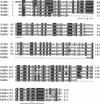Abstract
The gene encoding the major NAD(P)H-flavin oxidoreductase (flavin reductase) of the luminous bacterium Vibrio fischeri ATCC 7744 was isolated by using synthetic oligonucleotide probes corresponding to the N-terminal amino acid sequence of the enzyme. Nucleotide sequence analysis suggested that the major flavin reductase of V. fischeri consisted of 218 amino acids and had a calculated molecular weight of 24,562. Cloned flavin reductase expressed in Escherichia coli was purified virtually to homogeneity, and its basic biochemical properties were examined. As in the major flavin reductase in crude extracts of V. fischeri, cloned flavin reductase showed broad substrate specificity and served well as a catalyst to supply reduced flavin mononucleotide (FMNH2) to the bioluminescence reaction. The major flavin reductase of V. fischeri not only showed significant similarity in amino acid sequence to oxygen-insensitive NAD(P)H nitroreductases of Salmonella typhimurium, Enterobacter cloacae, and E. coli but also was associated with a low level of nitroreductase activity. The major flavin reductase of V. fischeri and the nitroreductases of members of the family Enterobacteriaceae would thus appear closely related in evolution and form a novel protein family.
Full text
PDF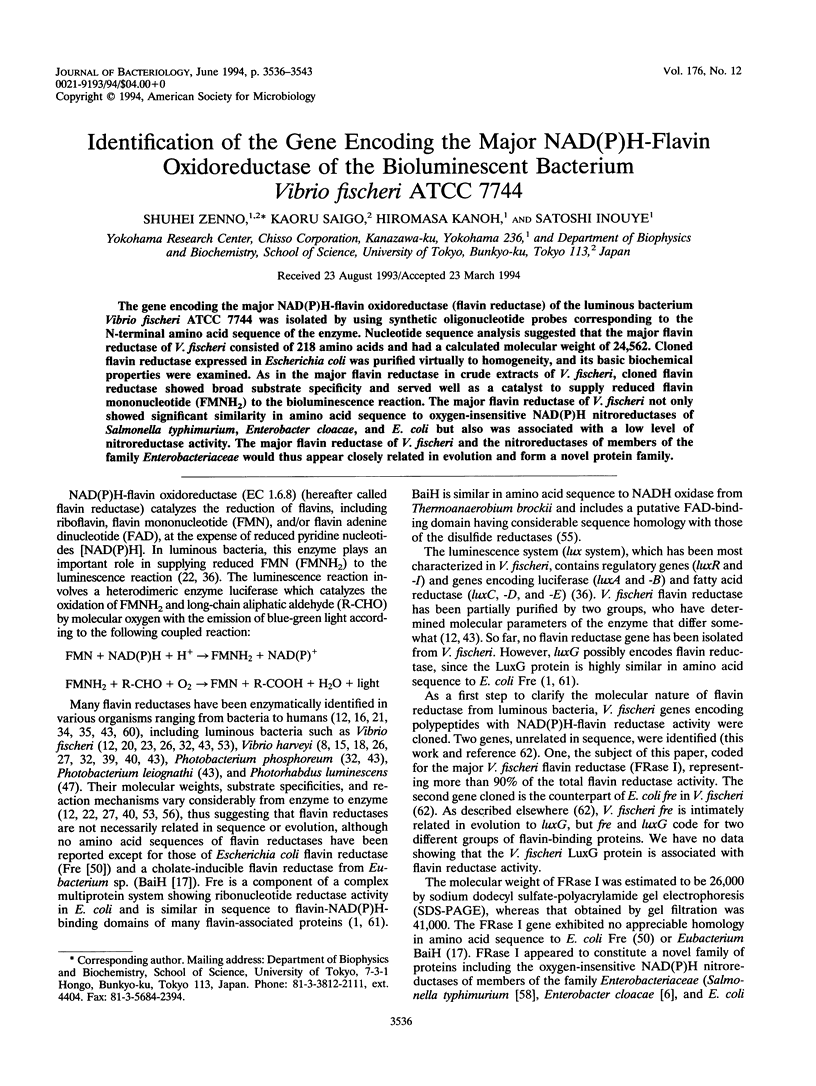
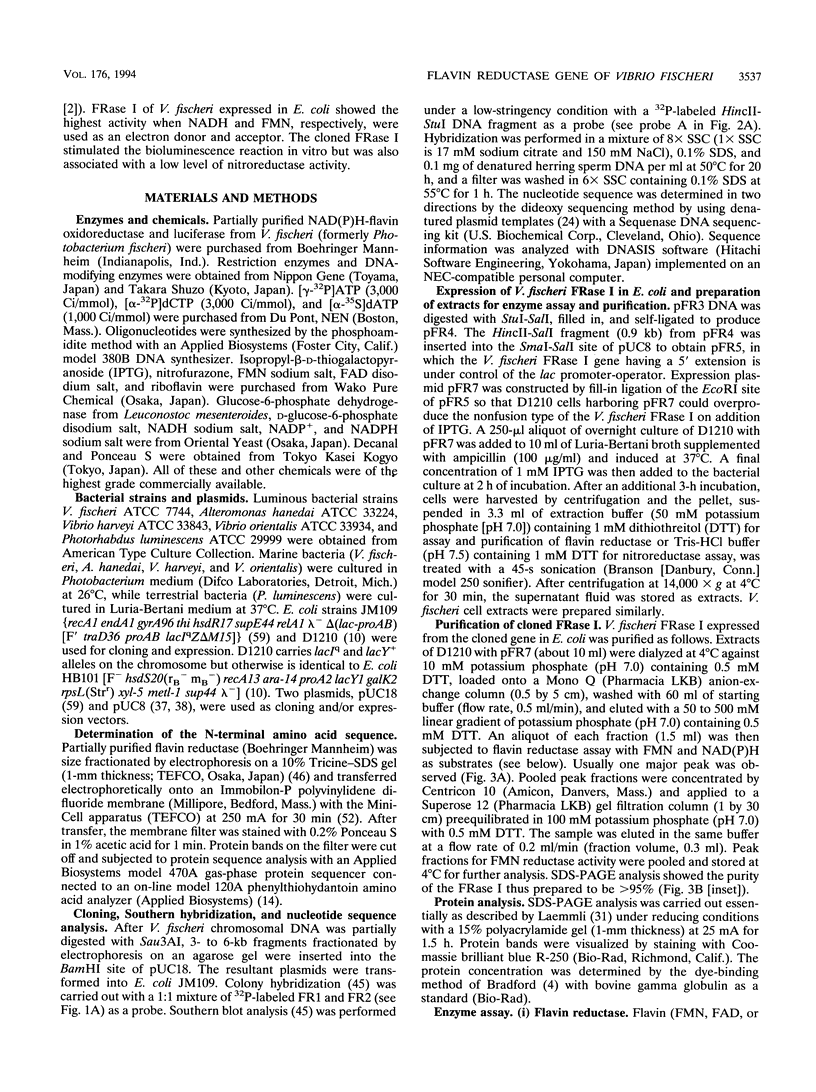
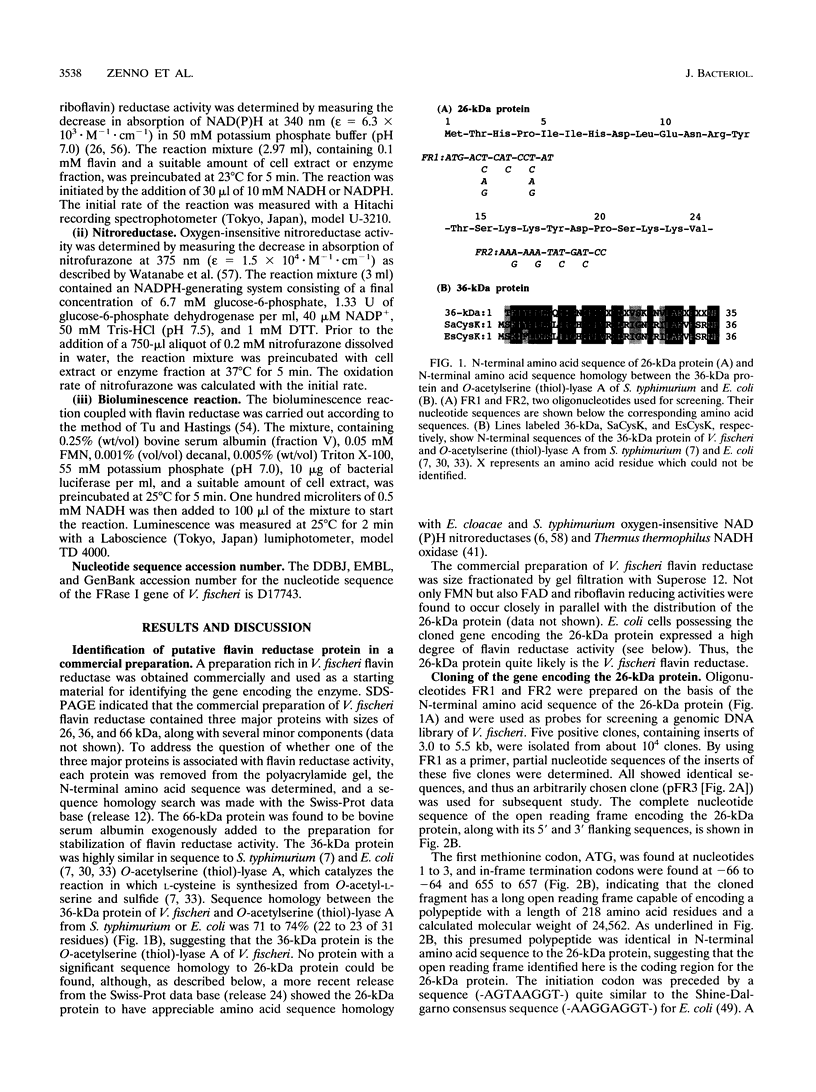
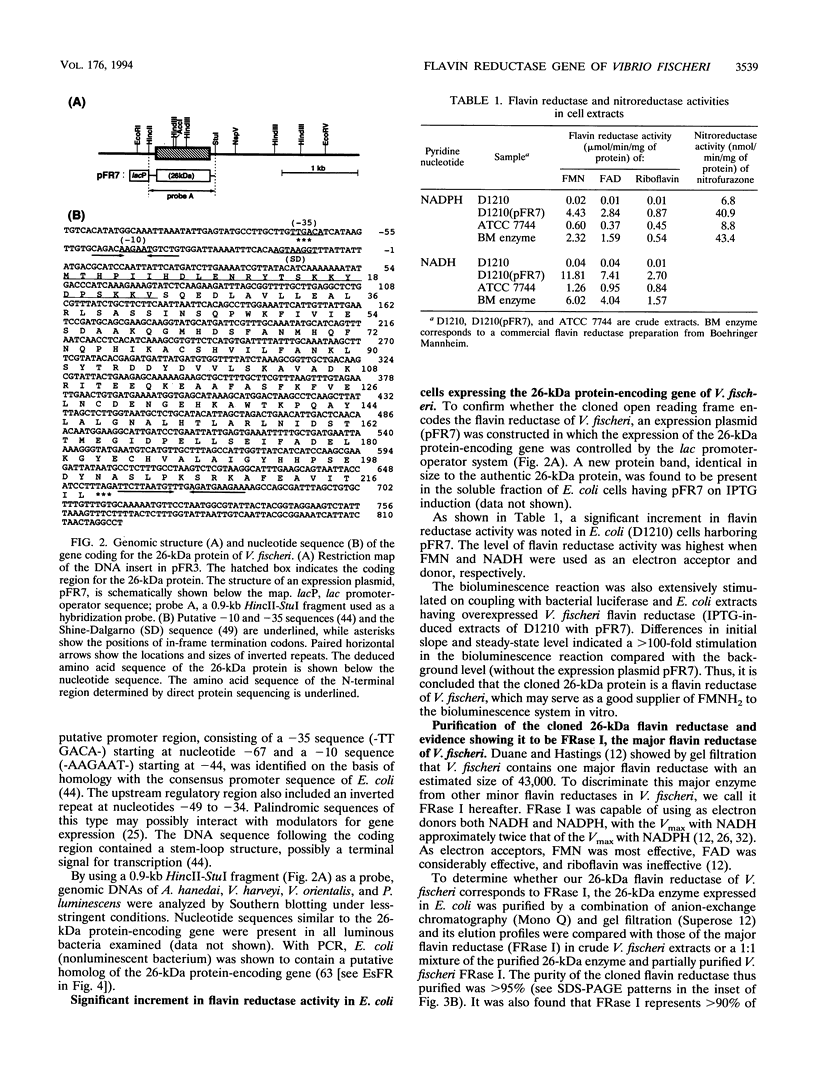
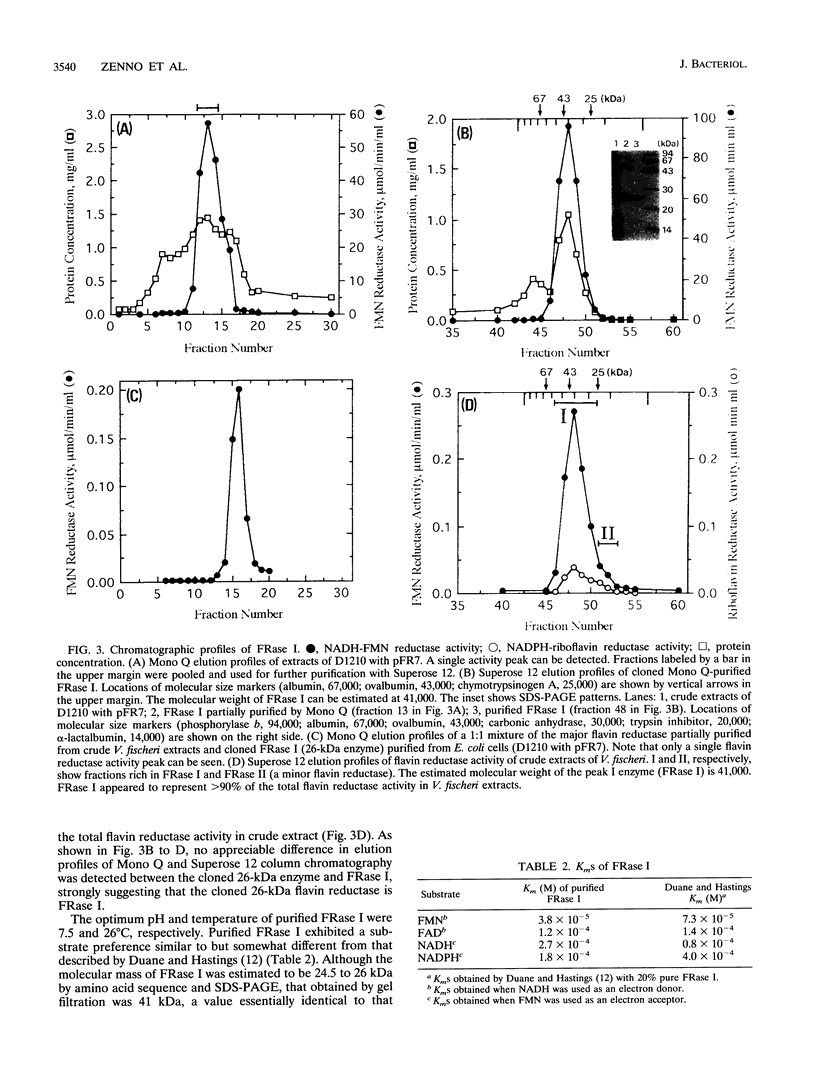
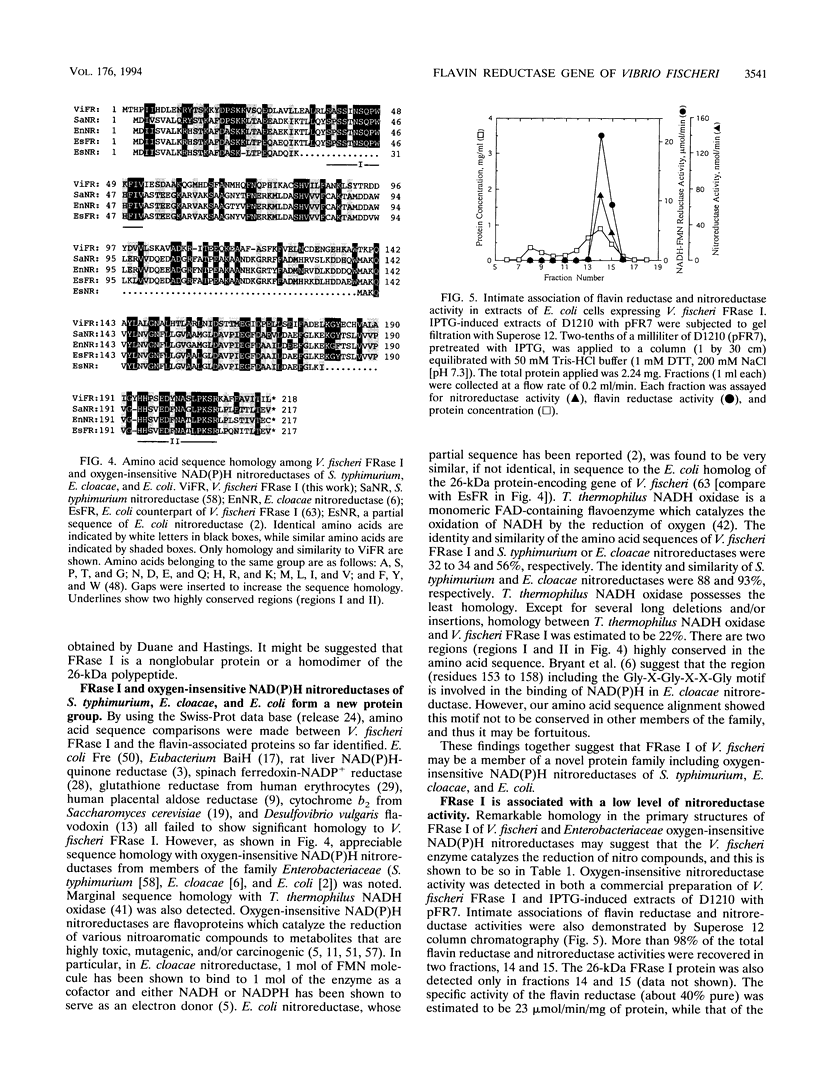
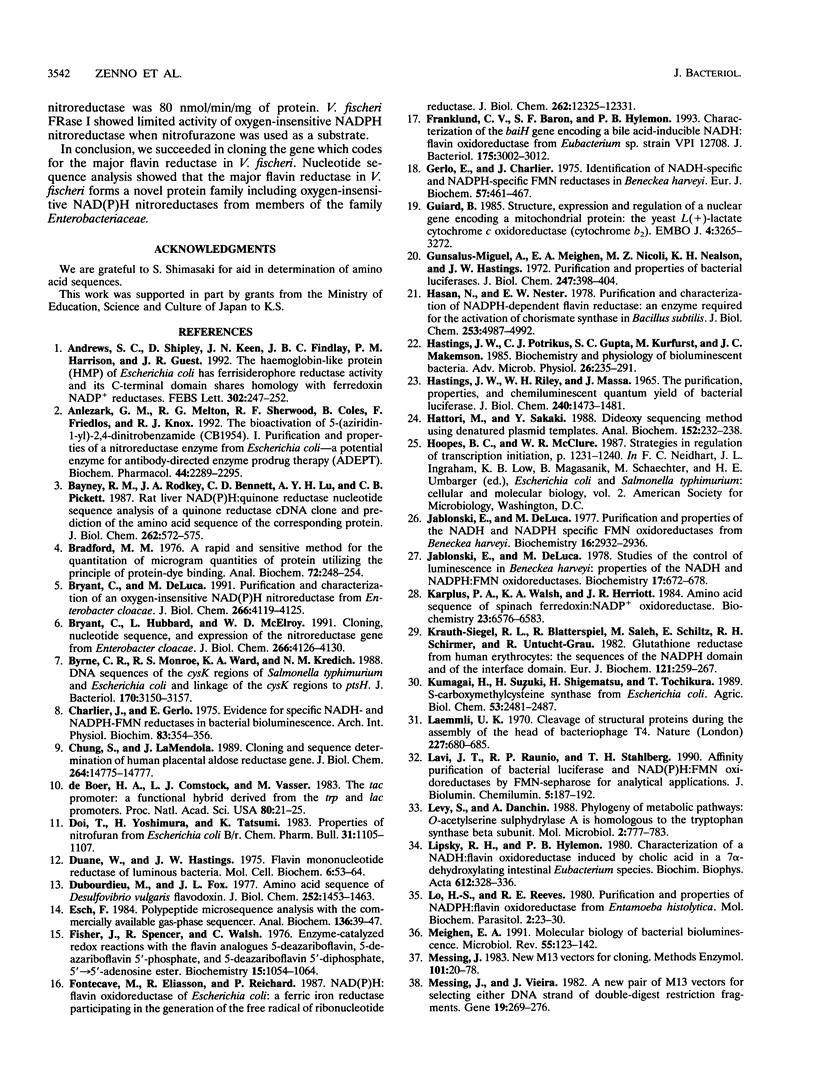
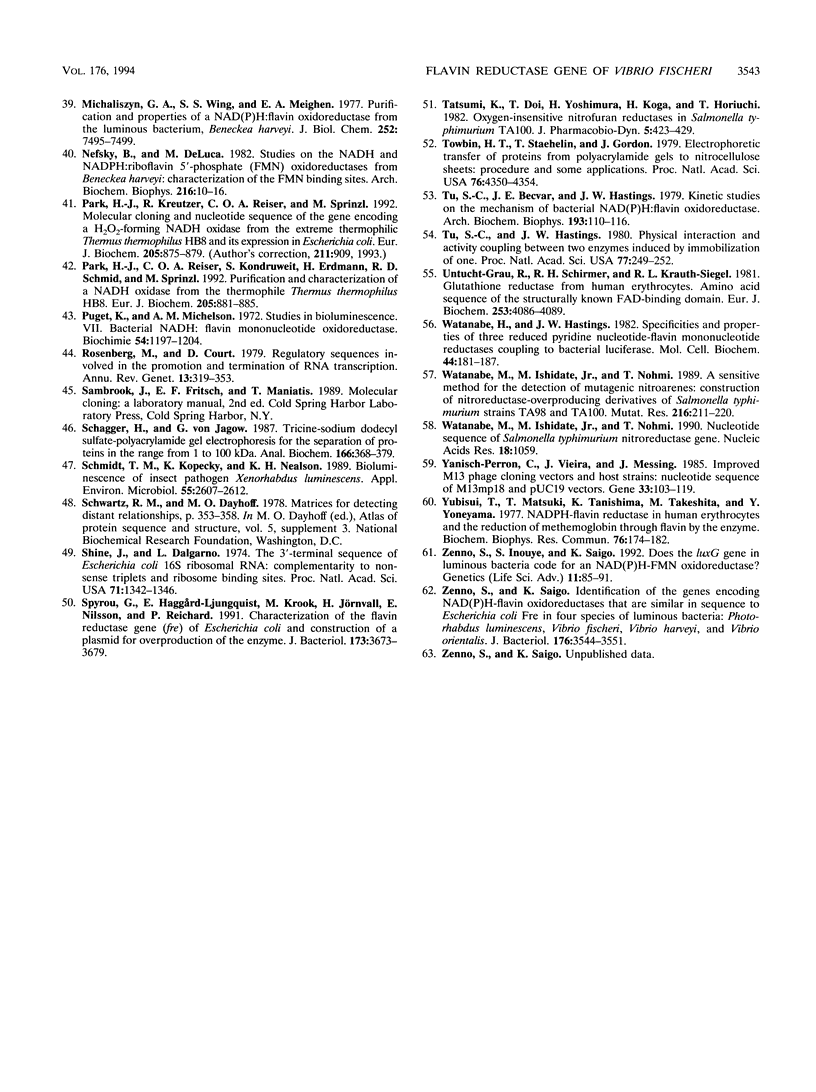
Images in this article
Selected References
These references are in PubMed. This may not be the complete list of references from this article.
- Andrews S. C., Shipley D., Keen J. N., Findlay J. B., Harrison P. M., Guest J. R. The haemoglobin-like protein (HMP) of Escherichia coli has ferrisiderophore reductase activity and its C-terminal domain shares homology with ferredoxin NADP+ reductases. FEBS Lett. 1992 May 18;302(3):247–252. doi: 10.1016/0014-5793(92)80452-m. [DOI] [PubMed] [Google Scholar]
- Anlezark G. M., Melton R. G., Sherwood R. F., Coles B., Friedlos F., Knox R. J. The bioactivation of 5-(aziridin-1-yl)-2,4-dinitrobenzamide (CB1954)--I. Purification and properties of a nitroreductase enzyme from Escherichia coli--a potential enzyme for antibody-directed enzyme prodrug therapy (ADEPT). Biochem Pharmacol. 1992 Dec 15;44(12):2289–2295. doi: 10.1016/0006-2952(92)90671-5. [DOI] [PubMed] [Google Scholar]
- Bayney R. M., Rodkey J. A., Bennett C. D., Lu A. Y., Pickett C. B. Rat liver NAD(P)H: quinone reductase nucleotide sequence analysis of a quinone reductase cDNA clone and prediction of the amino acid sequence of the corresponding protein. J Biol Chem. 1987 Jan 15;262(2):572–575. [PubMed] [Google Scholar]
- Bradford M. M. A rapid and sensitive method for the quantitation of microgram quantities of protein utilizing the principle of protein-dye binding. Anal Biochem. 1976 May 7;72:248–254. doi: 10.1006/abio.1976.9999. [DOI] [PubMed] [Google Scholar]
- Bryant C., DeLuca M. Purification and characterization of an oxygen-insensitive NAD(P)H nitroreductase from Enterobacter cloacae. J Biol Chem. 1991 Mar 5;266(7):4119–4125. [PubMed] [Google Scholar]
- Bryant C., Hubbard L., McElroy W. D. Cloning, nucleotide sequence, and expression of the nitroreductase gene from Enterobacter cloacae. J Biol Chem. 1991 Mar 5;266(7):4126–4130. [PubMed] [Google Scholar]
- Byrne C. R., Monroe R. S., Ward K. A., Kredich N. M. DNA sequences of the cysK regions of Salmonella typhimurium and Escherichia coli and linkage of the cysK regions to ptsH. J Bacteriol. 1988 Jul;170(7):3150–3157. doi: 10.1128/jb.170.7.3150-3157.1988. [DOI] [PMC free article] [PubMed] [Google Scholar]
- Charlier J., Gerlo E. Proceedings: Evidence for specific NADH- and NADPH-FMN reductases in bacterial bioluminescence. Arch Int Physiol Biochim. 1975 May;83(2):354–356. [PubMed] [Google Scholar]
- Chung S., LaMendola J. Cloning and sequence determination of human placental aldose reductase gene. J Biol Chem. 1989 Sep 5;264(25):14775–14777. [PubMed] [Google Scholar]
- Doi T., Yoshimura H., Tatsumi K. Properties of nitrofuran reductases from Escherichia coli B/r. Chem Pharm Bull (Tokyo) 1983 Mar;31(3):1105–1107. doi: 10.1248/cpb.31.1105. [DOI] [PubMed] [Google Scholar]
- Duane W., Hastings J. W. Flavin mononucleotide reductase of luminous bacteria. Mol Cell Biochem. 1975 Jan 31;6(1):53–64. doi: 10.1007/BF01731866. [DOI] [PubMed] [Google Scholar]
- Dubourdieu M., Fox J. L. Amino acid sequence of Desulfovibrio vulgaris flavodoxin. J Biol Chem. 1977 Feb 25;252(4):1453–1463. [PubMed] [Google Scholar]
- Esch F. S. Polypeptide microsequence analysis with the commercially available gas-phase sequencer. Anal Biochem. 1984 Jan;136(1):39–47. doi: 10.1016/0003-2697(84)90305-1. [DOI] [PubMed] [Google Scholar]
- Fisher J., Spencer R., Walsh C. Enzyme-catalyzed redox reactions with the flavin analogues 5-deazariboflavin, 5-deazariboflavin 5'-phosphte, and 5-deazariboflavin 5'-diphosphate, 5' leads to 5'-adenosine ester. Biochemistry. 1976 Mar 9;15(5):1054–1064. doi: 10.1021/bi00650a016. [DOI] [PubMed] [Google Scholar]
- Fontecave M., Eliasson R., Reichard P. NAD(P)H:flavin oxidoreductase of Escherichia coli. A ferric iron reductase participating in the generation of the free radical of ribonucleotide reductase. J Biol Chem. 1987 Sep 5;262(25):12325–12331. [PubMed] [Google Scholar]
- Franklund C. V., Baron S. F., Hylemon P. B. Characterization of the baiH gene encoding a bile acid-inducible NADH:flavin oxidoreductase from Eubacterium sp. strain VPI 12708. J Bacteriol. 1993 May;175(10):3002–3012. doi: 10.1128/jb.175.10.3002-3012.1993. [DOI] [PMC free article] [PubMed] [Google Scholar]
- Gerlo E., Charlier J. Identification of NADH-specific and NADPH-specific FMN reductases in Beneckea harveyi. Eur J Biochem. 1975 Sep 15;57(2):461–467. doi: 10.1111/j.1432-1033.1975.tb02321.x. [DOI] [PubMed] [Google Scholar]
- Guiard B. Structure, expression and regulation of a nuclear gene encoding a mitochondrial protein: the yeast L(+)-lactate cytochrome c oxidoreductase (cytochrome b2). EMBO J. 1985 Dec 1;4(12):3265–3272. doi: 10.1002/j.1460-2075.1985.tb04076.x. [DOI] [PMC free article] [PubMed] [Google Scholar]
- Gunsalus-Miguel A., Meighen E. A., Nicoli M. Z., Nealson K. H., Hastings J. W. Purification and properties of bacterial luciferases. J Biol Chem. 1972 Jan 25;247(2):398–404. [PubMed] [Google Scholar]
- HASTINGS J. W., RILEY W. H., MASSA J. THE PURIFICATION PROPERTIES, AND CHEMILUMINESCENT QUANTUM YIELD OF BACTERIAL LUCIFERASE. J Biol Chem. 1965 Mar;240:1473–1481. [PubMed] [Google Scholar]
- Hasan N., Nester E. W. Purification and characterization of NADPH-dependent flavin reductase. An enzyme required for the activation of chorismate synthase in Bacillus subtilis. J Biol Chem. 1978 Jul 25;253(14):4987–4992. [PubMed] [Google Scholar]
- Hastings J. W., Potrikus C. J., Gupta S. C., Kurfürst M., Makemson J. C. Biochemistry and physiology of bioluminescent bacteria. Adv Microb Physiol. 1985;26:235–291. doi: 10.1016/s0065-2911(08)60398-7. [DOI] [PubMed] [Google Scholar]
- Hattori M., Sakaki Y. Dideoxy sequencing method using denatured plasmid templates. Anal Biochem. 1986 Feb 1;152(2):232–238. doi: 10.1016/0003-2697(86)90403-3. [DOI] [PubMed] [Google Scholar]
- Jablonski E., DeLuca M. Purification and properties of the NADH and NADPH specific FMN oxidoreductases from Beneckea harveyi. Biochemistry. 1977 Jun 28;16(13):2932–2936. doi: 10.1021/bi00632a020. [DOI] [PubMed] [Google Scholar]
- Jablonski E., DeLuca M. Studies of the control of luminescence in Beneckea harveyi: properties of the NADH and NADPH:FMN oxidoreductases. Biochemistry. 1978 Feb 21;17(4):672–678. doi: 10.1021/bi00597a018. [DOI] [PubMed] [Google Scholar]
- Karplus P. A., Walsh K. A., Herriott J. R. Amino acid sequence of spinach ferredoxin:NADP+ oxidoreductase. Biochemistry. 1984 Dec 18;23(26):6576–6583. doi: 10.1021/bi00321a046. [DOI] [PubMed] [Google Scholar]
- Krauth-Siegel R. L., Blatterspiel R., Saleh M., Schiltz E., Schirmer R. H., Untucht-Grau R. Glutathione reductase from human erythrocytes. The sequences of the NADPH domain and of the interface domain. Eur J Biochem. 1982 Jan;121(2):259–267. doi: 10.1111/j.1432-1033.1982.tb05780.x. [DOI] [PubMed] [Google Scholar]
- Laemmli U. K. Cleavage of structural proteins during the assembly of the head of bacteriophage T4. Nature. 1970 Aug 15;227(5259):680–685. doi: 10.1038/227680a0. [DOI] [PubMed] [Google Scholar]
- Lavi J. T., Raunio R. P., Stahlberg T. H. Affinity purification of bacterial luciferase and NAD(P)H:FMN oxidoreductases by FMN-sepharose for analytical applications. J Biolumin Chemilumin. 1990 Jul-Sep;5(3):187–192. doi: 10.1002/bio.1170050308. [DOI] [PubMed] [Google Scholar]
- Levy S., Danchin A. Phylogeny of metabolic pathways: O-acetylserine sulphydrylase A is homologous to the tryptophan synthase beta subunit. Mol Microbiol. 1988 Nov;2(6):777–783. doi: 10.1111/j.1365-2958.1988.tb00089.x. [DOI] [PubMed] [Google Scholar]
- Lipsky R. H., Hylemon P. B. Characterization of a NADH:flavin oxidoreductase induced by cholic acid in a 7 alpha-dehydroxylating intestinal Eubacterium species. Biochim Biophys Acta. 1980 Apr 11;612(2):328–336. doi: 10.1016/0005-2744(80)90115-1. [DOI] [PubMed] [Google Scholar]
- Lo H., Reeves R. E. Purification and properties of NADPH:flavin oxidoreductase from Entamoeba histolytica. Mol Biochem Parasitol. 1980 Oct;2(1):23–30. doi: 10.1016/0166-6851(80)90045-6. [DOI] [PubMed] [Google Scholar]
- Meighen E. A. Molecular biology of bacterial bioluminescence. Microbiol Rev. 1991 Mar;55(1):123–142. doi: 10.1128/mr.55.1.123-142.1991. [DOI] [PMC free article] [PubMed] [Google Scholar]
- Messing J. New M13 vectors for cloning. Methods Enzymol. 1983;101:20–78. doi: 10.1016/0076-6879(83)01005-8. [DOI] [PubMed] [Google Scholar]
- Messing J., Vieira J. A new pair of M13 vectors for selecting either DNA strand of double-digest restriction fragments. Gene. 1982 Oct;19(3):269–276. doi: 10.1016/0378-1119(82)90016-6. [DOI] [PubMed] [Google Scholar]
- Michaliszyn G. A., Wing S. S., Meighen E. A. Purification and properties of a NAD(P)H:flavin oxidoreductase from the luminous bacterium, Beneckea harveyi. J Biol Chem. 1977 Nov 10;252(21):7495–7499. [PubMed] [Google Scholar]
- Nefsky B., DeLuca M. Studies on the NADH and NADPH: riboflavin 5'-phosphate (FMN) oxidoreductases from Beneckea harveyi: characterization of the FMN binding sites. Arch Biochem Biophys. 1982 Jun;216(1):10–16. doi: 10.1016/0003-9861(82)90182-5. [DOI] [PubMed] [Google Scholar]
- Park H. J., Kreutzer R., Reiser C. O., Sprinzl M. Molecular cloning and nucleotide sequence of the gene encoding a H2O2-forming NADH oxidase from the extreme thermophilic Thermus thermophilus HB8 and its expression in Escherichia coli. Eur J Biochem. 1992 May 1;205(3):875–879. doi: 10.1111/j.1432-1033.1992.tb16852.x. [DOI] [PubMed] [Google Scholar]
- Park H. J., Reiser C. O., Kondruweit S., Erdmann H., Schmid R. D., Sprinzl M. Purification and characterization of a NADH oxidase from the thermophile Thermus thermophilus HB8. Eur J Biochem. 1992 May 1;205(3):881–885. doi: 10.1111/j.1432-1033.1992.tb16853.x. [DOI] [PubMed] [Google Scholar]
- Puget K., Michelson A. M. Studies in bioluminescence. VII. Bacterial NADH: flavin mononucleotide oxidoreductase. Biochimie. 1972;54(9):1197–1204. doi: 10.1016/s0300-9084(72)80024-5. [DOI] [PubMed] [Google Scholar]
- Rosenberg M., Court D. Regulatory sequences involved in the promotion and termination of RNA transcription. Annu Rev Genet. 1979;13:319–353. doi: 10.1146/annurev.ge.13.120179.001535. [DOI] [PubMed] [Google Scholar]
- Schmidt T. M., Kopecky K., Nealson K. H. Bioluminescence of the insect pathogen Xenorhabdus luminescens. Appl Environ Microbiol. 1989 Oct;55(10):2607–2612. doi: 10.1128/aem.55.10.2607-2612.1989. [DOI] [PMC free article] [PubMed] [Google Scholar]
- Schägger H., von Jagow G. Tricine-sodium dodecyl sulfate-polyacrylamide gel electrophoresis for the separation of proteins in the range from 1 to 100 kDa. Anal Biochem. 1987 Nov 1;166(2):368–379. doi: 10.1016/0003-2697(87)90587-2. [DOI] [PubMed] [Google Scholar]
- Shine J., Dalgarno L. The 3'-terminal sequence of Escherichia coli 16S ribosomal RNA: complementarity to nonsense triplets and ribosome binding sites. Proc Natl Acad Sci U S A. 1974 Apr;71(4):1342–1346. doi: 10.1073/pnas.71.4.1342. [DOI] [PMC free article] [PubMed] [Google Scholar]
- Spyrou G., Haggård-Ljungquist E., Krook M., Jörnvall H., Nilsson E., Reichard P. Characterization of the flavin reductase gene (fre) of Escherichia coli and construction of a plasmid for overproduction of the enzyme. J Bacteriol. 1991 Jun;173(12):3673–3679. doi: 10.1128/jb.173.12.3673-3679.1991. [DOI] [PMC free article] [PubMed] [Google Scholar]
- Tatsumi K., Doi T., Yoshimura H., Koga H., Horiuchi T. Oxygen--insensitive nitrofuran reductases in Salmonella typhimurium TA100. J Pharmacobiodyn. 1982 Jun;5(6):423–429. doi: 10.1248/bpb1978.5.423. [DOI] [PubMed] [Google Scholar]
- Towbin H., Staehelin T., Gordon J. Electrophoretic transfer of proteins from polyacrylamide gels to nitrocellulose sheets: procedure and some applications. Proc Natl Acad Sci U S A. 1979 Sep;76(9):4350–4354. doi: 10.1073/pnas.76.9.4350. [DOI] [PMC free article] [PubMed] [Google Scholar]
- Tu S. C., Becvar J. E., Hastings J. W. Kinetic studies on the mechanism of bacterial NAD(P)H:flavin oxidoreductase. Arch Biochem Biophys. 1979 Mar;193(1):110–116. doi: 10.1016/0003-9861(79)90013-4. [DOI] [PubMed] [Google Scholar]
- Tu S. C., Hastings J. W. Physical interaction and activity coupling between two enzymes induced by immobilization of one. Proc Natl Acad Sci U S A. 1980 Jan;77(1):249–252. doi: 10.1073/pnas.77.1.249. [DOI] [PMC free article] [PubMed] [Google Scholar]
- Watanabe H., Hastings J. W. Specificities and properties of three reduced pyridine nucleotide-flavin mononucleotide reductases coupling to bacterial luciferase. Mol Cell Biochem. 1982 May 14;44(3):181–187. doi: 10.1007/BF00238506. [DOI] [PubMed] [Google Scholar]
- Watanabe M., Ishidate M., Jr, Nohmi T. A sensitive method for the detection of mutagenic nitroarenes: construction of nitroreductase-overproducing derivatives of Salmonella typhimurium strains TA98 and TA100. Mutat Res. 1989 Aug;216(4):211–220. doi: 10.1016/0165-1161(89)90007-1. [DOI] [PubMed] [Google Scholar]
- Watanabe M., Ishidate M., Jr, Nohmi T. Nucleotide sequence of Salmonella typhimurium nitroreductase gene. Nucleic Acids Res. 1990 Feb 25;18(4):1059–1059. doi: 10.1093/nar/18.4.1059. [DOI] [PMC free article] [PubMed] [Google Scholar]
- Yanisch-Perron C., Vieira J., Messing J. Improved M13 phage cloning vectors and host strains: nucleotide sequences of the M13mp18 and pUC19 vectors. Gene. 1985;33(1):103–119. doi: 10.1016/0378-1119(85)90120-9. [DOI] [PubMed] [Google Scholar]
- Yubisui T., Matsuki T., Tanishima K., Takeshita M., Yoneyama Y. NADPH-flavin reductase in human erythrocytes and the reduction of methemoglobin through flavin by the enzyme. Biochem Biophys Res Commun. 1977 May 9;76(1):174–182. doi: 10.1016/0006-291x(77)91683-7. [DOI] [PubMed] [Google Scholar]
- Zenno S., Saigo K. Identification of the genes encoding NAD(P)H-flavin oxidoreductases that are similar in sequence to Escherichia coli Fre in four species of luminous bacteria: Photorhabdus luminescens, Vibrio fischeri, Vibrio harveyi, and Vibrio orientalis. J Bacteriol. 1994 Jun;176(12):3544–3551. doi: 10.1128/jb.176.12.3544-3551.1994. [DOI] [PMC free article] [PubMed] [Google Scholar]
- de Boer H. A., Comstock L. J., Vasser M. The tac promoter: a functional hybrid derived from the trp and lac promoters. Proc Natl Acad Sci U S A. 1983 Jan;80(1):21–25. doi: 10.1073/pnas.80.1.21. [DOI] [PMC free article] [PubMed] [Google Scholar]




